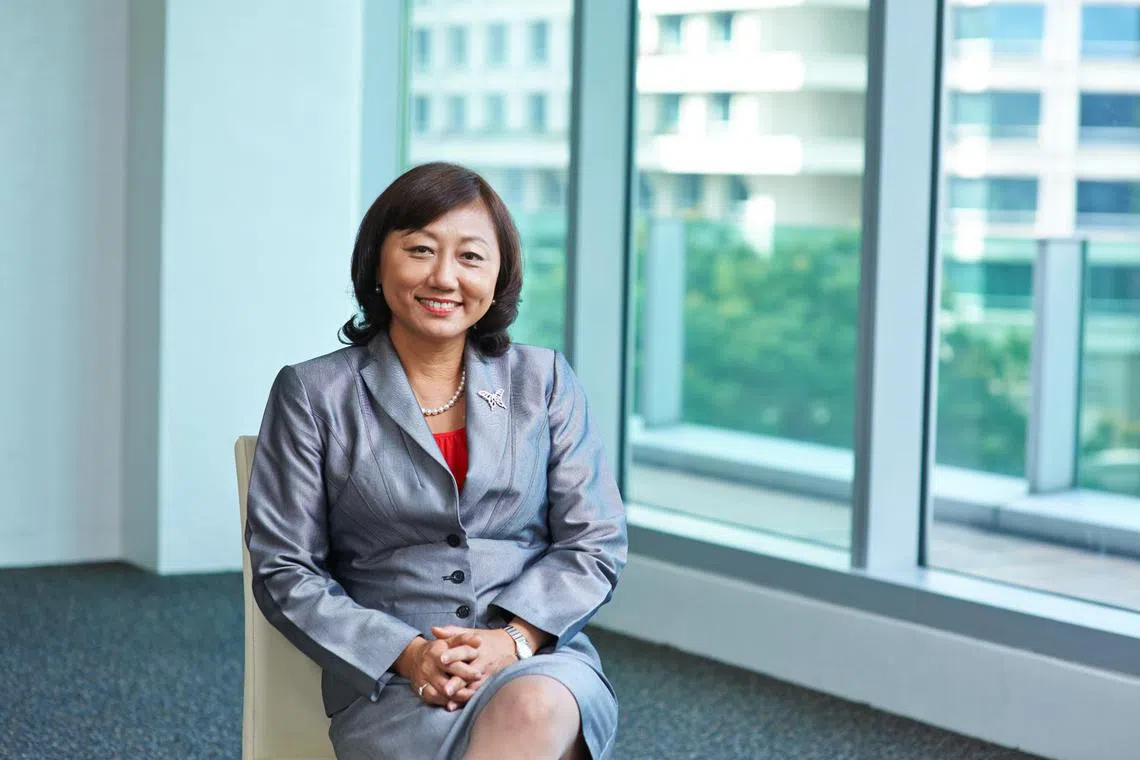Azalea launches latest series of Astrea private equity-backed bonds for retail investors
Sign up now: Get ST's newsletters delivered to your inbox

Azalea chief executive Margaret Lui says the firm is committed to democratising private equity for all investors, including retail investors in Singapore.
PHOTO: AZALEA INVESTMENT MANAGEMENT
Genevieve Cua
Follow topic:
SINGAPORE – Azalea Asset Management has launched for public subscription its latest issue of private equity-backed bonds – Astrea 8.
The issue is set to attract a strong response, thanks to the investing public’s keen appetite for yield and a macro environment where interest rates have likely peaked and may soften later in 2024.
The Astrea 8 bonds comprise $260 million worth of Class A-1 bonds in Singapore dollars that will carry a fixed coupon of 4.35 per cent, and US$50 million (S$67.4 million) worth of Class A-2 bonds in US dollars with a fixed coupon of 6.35 per cent.
Azalea is part of the Temasek group and manages around US$9 billion in assets.
The public offer follows the successful placement of $260 million of Class A-1 bonds and US$150 million of Class A-2 bonds for institutional and accredited investors on July 10.
The placement tranche saw strong demand from institutions, including endowments, pensions, insurance companies and asset managers, with a combined placement order book in excess of $1.2 billion. This is equivalent to a subscription rate of 2.6 times.
Fitch has issued a tentative A+ rating for the Class A-1 bonds, and A for the Class A-2 bonds.
The minimum subscription for Class A-1 bonds is $2,000, and for Class A-2 bonds, it is US$2,000. For subscribers for the Class A-2 bonds, the exchange rate is fixed at US$1 to S$1.35.
Both classes of bonds have a final maturity of 15 years, with a mandatory call at the end of five years for Class A-1 bonds, and at the end of six years for Class A-2 bonds.
The public offer opened at 9am on July 11 and closes at 12pm on July 17. The bonds will be issued on July 19 and will list on the Singapore Exchange on July 22.
Azalea chief executive Margaret Lui said: “This latest issuance underscores our dedication to democratising private equity for all investors, including retail investors in Singapore, and reaffirms our commitment to product innovation. The Astrea 8 private equity (PE) bonds offer Singapore retail investors a unique opportunity to invest in investment-grade bonds that provide quality, diversified PE exposure through a steady income stream.”
The Astrea series of PE bonds have built a strong track record of credit rating upgrades and steady distributions. Even through the Covid-19 pandemic, for example, the Astrea IV and V portfolios generated sufficient cash flows to fulfil all bond obligations, and their credit facilities were not utilised.

GRAPHIC: THE BUSINESS TIMES
Among lower-risk options in the market, current fixed deposit rates for up to 12 months’ tenor range between 3 per cent and 3.5 per cent a year. The current Singapore Savings Bond is offered at an average 3.22 per cent a year over 10 years. The 10-year Singapore government bond currently yields around 3.2 per cent.
Based on global indexes, US investment-grade corporate bonds currently yield more than 5 per cent. The Astrea issuances are more comparable to investment-grade corporate bonds, but such bonds are less accessible for retail investors due to the investment ticket size of $200,000 to $250,000.
The underlying PE portfolio for the latest Astrea 8 issuance comprises 38 PE funds by 27 managers, valued at US$1.5 billion. Buyout strategies comprise 76 per cent of exposure, and growth strategies, 24 per cent.
The portfolio is diversified across more than 1,000 companies, where the single largest exposure is 1.3 per cent of net asset value. The weighted average fund age is 6.1 years, which is “highly cash flow generative”, said Azalea chief investment officer Chue En Yaw.
Mr Chue said mature PE funds are more likely to generate cash flow.
“Over 10 to 12 years of a fund’s life cycle, the first four to five years are the investing period. In the final five to 10 years, the fund is divesting companies to return cash to investors,” he said.
Cash flows from underlying holdings are used to fund coupon payments to bond holders.
Astrea funds are designed with structural features to protect retail investors.
To ensure alignment of interest, for example, sponsor Azalea will hold 60 per cent of the portfolio’s equity. The portfolio will need to lose 60.2 per cent of value before bond holders are affected. There is a reserve account to ensure a cash build-up to repay principal amounts, and the loan-to-value ratio must be maintained at under 40 per cent.
There is also a prescribed sequence of priority payments so that cash is reserved for retail bond holders.
Mr Wong Di Ming of Bondsupermart wrote in an analysis: “The Astrea portfolios have largely seen positive results over the years, especially demonstrated by their cash distributions, some of which have reached above 100 per cent of the net asset value. This illustrates a relatively resilient PE performance over the years, on top of being able to withstand the economic downturn during the Covid-19 pandemic...
“We like two aspects of the Astrea portfolios over the years – a deleveraging of the portfolios as shown by the falling loan-to-value ratios, and a growing assurance for bond holders with the consistent credit rating upgrades.” THE BUSINESS TIMES

